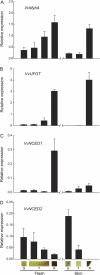Fruit ripening in Vitis vinifera: spatiotemporal relationships among turgor, sugar accumulation, and anthocyanin biosynthesis
- PMID: 21586429
- PMCID: PMC3153685
- DOI: 10.1093/jxb/err150
Fruit ripening in Vitis vinifera: spatiotemporal relationships among turgor, sugar accumulation, and anthocyanin biosynthesis
Abstract
This study reports the first observations indicating the spatiotemporal relationships among genetic and physiological aspects of ripening in the berry of Vitis vinifera. At the onset of ripening in the red flesh variety Alicante Bouschet, colour development began in the flesh at the stylar end of the fruit and progressed toward the pedicel end flesh and into the skin. Tissue solute potential and cell turgor also decreased first in the flesh. The decrease in flesh solute potential was due to accumulation of sugars, glucose and fructose, an accumulation that is integral to ripening. Expression of the anthocyanin biosynthesis-related genes VvMybA and VvUFGT was linearly related to the decrease in solute potential. Expression of VvMybA, and to a lesser extent VvUFGT, was correspondingly low in green tissue, higher in the red, stylar end flesh of berries beginning to ripen, and greatest in red berries. In contrast, expression of the abscisic acid biosynthesis-related genes VvNCED1 and VvNCED2 was not correlated with the other spatiotemporal aspects of the onset of ripening. These results, together with earlier work showing that sugar accumulation and acid loss also begin in the stylar flesh in other varieties, indicate that ripening in the grape berry originates in the stylar end flesh.
Figures





Similar articles
-
Characterization of major ripening events during softening in grape: turgor, sugar accumulation, abscisic acid metabolism, colour development, and their relationship with growth.J Exp Bot. 2016 Feb;67(3):709-22. doi: 10.1093/jxb/erv483. Epub 2015 Nov 17. J Exp Bot. 2016. PMID: 26590311 Free PMC article.
-
Transcriptomic and metabolite analyses of Cabernet Sauvignon grape berry development.BMC Genomics. 2007 Nov 22;8:429. doi: 10.1186/1471-2164-8-429. BMC Genomics. 2007. PMID: 18034876 Free PMC article.
-
Expression of flavonoid genes in the red grape berry of 'Alicante Bouschet' varies with the histological distribution of anthocyanins and their chemical composition.Planta. 2012 Oct;236(4):1037-51. doi: 10.1007/s00425-012-1658-2. Epub 2012 May 3. Planta. 2012. PMID: 22552639
-
An update on sugar transport and signalling in grapevine.J Exp Bot. 2014 Mar;65(3):821-32. doi: 10.1093/jxb/ert394. Epub 2013 Dec 9. J Exp Bot. 2014. PMID: 24323501 Review.
-
Berry shrivel in grapevine: a review considering multiple approaches.J Exp Bot. 2024 Apr 15;75(8):2196-2213. doi: 10.1093/jxb/erae001. J Exp Bot. 2024. PMID: 38174592 Free PMC article. Review.
Cited by
-
Genome-Wide Identification of Glutathione S-Transferase and Expression Analysis in Response to Anthocyanin Transport in the Flesh of the New Teinturier Grape Germplasm 'Zhongshan-HongYu'.Int J Mol Sci. 2022 Jul 13;23(14):7717. doi: 10.3390/ijms23147717. Int J Mol Sci. 2022. PMID: 35887065 Free PMC article.
-
Transcriptome changes during fruit development and ripening of sweet orange (Citrus sinensis).BMC Genomics. 2012 Jan 10;13:10. doi: 10.1186/1471-2164-13-10. BMC Genomics. 2012. PMID: 22230690 Free PMC article.
-
Softening at the onset of grape ripening alters fruit rheological properties and decreases splitting resistance.Planta. 2019 Oct;250(4):1293-1305. doi: 10.1007/s00425-019-03226-y. Epub 2019 Jun 28. Planta. 2019. PMID: 31254101
-
Cuticle and skin cell walls have common and unique roles in grape berry splitting.Hortic Res. 2021 Aug 1;8(1):168. doi: 10.1038/s41438-021-00602-2. Hortic Res. 2021. PMID: 34333518 Free PMC article.
-
Tissue-Specific Expression Analysis of Anthocyanin Biosynthetic Genes in White- and Red-Fleshed Grape Cultivars.Molecules. 2015 Dec 19;20(12):22767-80. doi: 10.3390/molecules201219883. Molecules. 2015. PMID: 26703539 Free PMC article.
References
-
- Ageorges A, Fernandez L, Vialet S, Merdinoglu D, Terrier N, Romieu C. Four specific isogenes of the anthocyanin metabolic pathway are systematically co-expressed with the red colour of grape berries. Plant Science. 2006;170:372–383.
-
- Boss PK, Davies C, Robinson SP. Expression of anthocyanin biosynthesis pathway genes in red and white grapes. Plant Molecular Biology. 1996b;32:565–569. - PubMed

